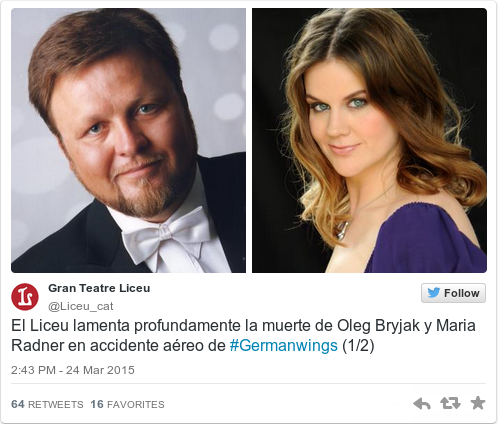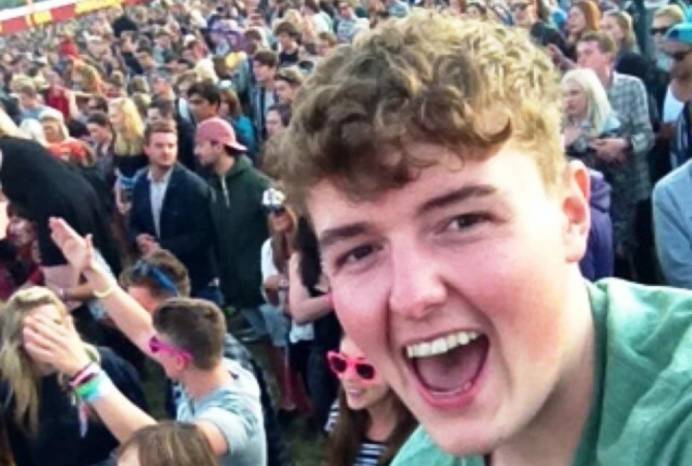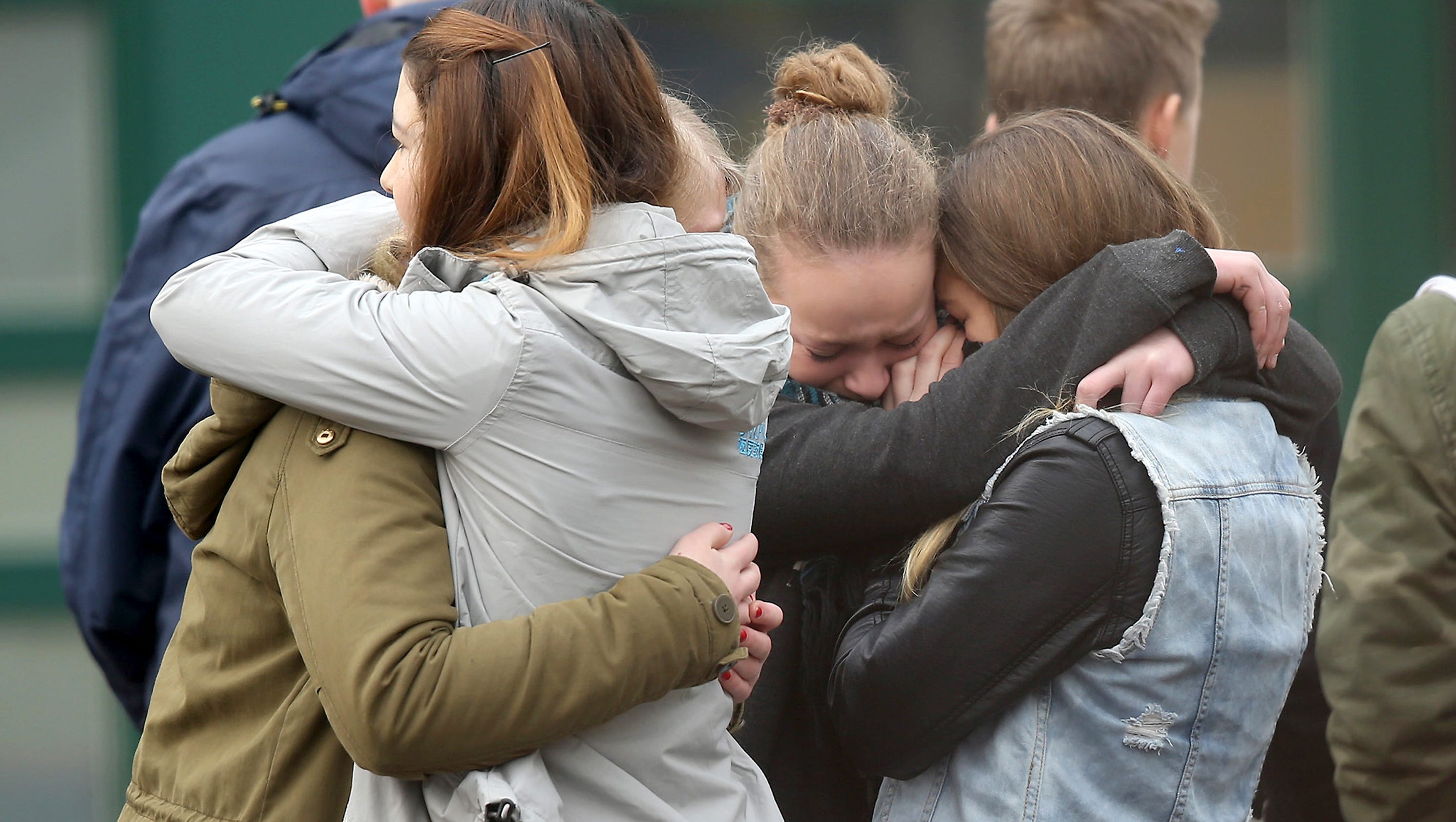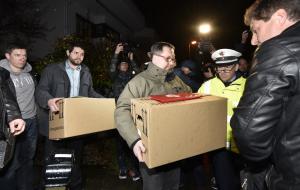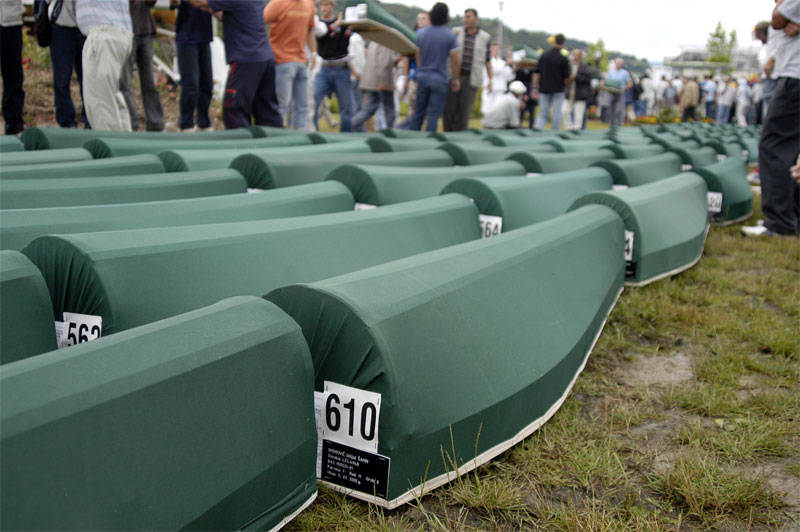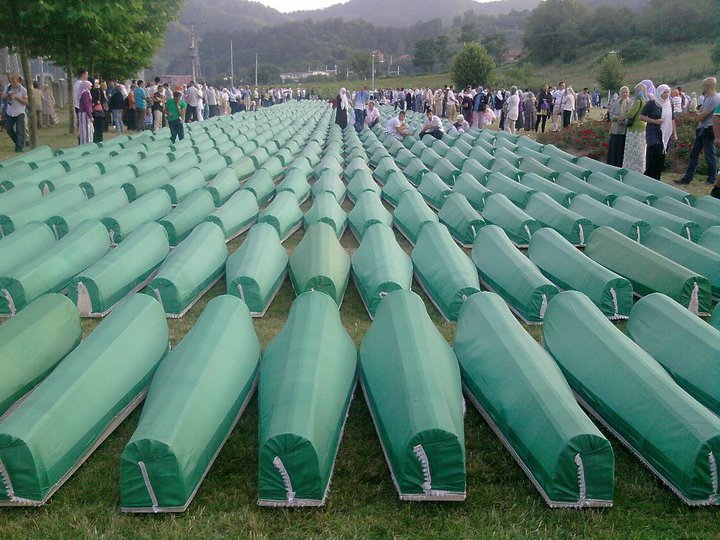
1992 ethnic cleansing campaign
The predominantly Bosniak area of Central
Podrinje (the region around Srebrenica) had a primary strategic importance to Serbs, as without it there would be no territorial integrity within their new political entity of
Republika Srpska.
[31] They thus proceeded with the
ethnic cleansing of Bosniaks from Bosniak ethnic territories in Eastern Bosnia and Central Podrinje. In the words of the ICTY judgement:
Once towns and villages were securely in their hands, the Serb forces – the military, the police, the paramilitaries and, sometimes, even Serb villagers – applied the same pattern: Muslim houses and apartments were systematically ransacked or burnt down, Muslim villagers were rounded up or captured and, in the process, sometimes beaten or killed. Men and women were separated, with many of the men detained in the former KP Dom prison.
[30]
In neighbouring
Bratunac, Bosniaks were either killed or forced to flee to Srebrenica, resulting in 1,156 deaths, according to Bosnian government data.
[32] Thousands of Bosniaks were also killed in
Foča,
Zvornik,
Cerska and Snagovo.
[33]
Fate of Bosniak villages
In 1992, Bosniak villages around Srebrenica were under constant attack by Serb forces. The Bosnian Institute in the UK has published a list of 296 villages destroyed by Serb forces around Srebrenica three years before the genocide and in the first three months of war (April – June 1992):
[34]
More than three years before the 1995 Srebrenica genocide, Bosnian Serb nationalists – with the logistical, moral and financial support of Serbia and the Yugoslav People's Army (JNA) – destroyed 296 predominantly Bosniak villages in the region around Srebrenica, forcibly uprooting some 70,000 Bosniaks from their homes and systematically massacring at least 3,166 Bosniaks (documented deaths) including many women, children and elderly.
Between April 1992 and March 1993, the town of Srebrenica and the villages in the area held by Bosniak were constantly subjected to Serb military assaults, including artillery attacks, sniper fire, as well as occasional bombing from aircraft. Each onslaught followed a similar pattern. Serb soldiers and paramilitaries surrounded a Bosnian Muslim village or hamlet, called upon the population to surrender their weapons, and then began with indiscriminate shelling and shooting. In most cases, they then entered the village or hamlet, expelled or killed the population, who offered no significant resistance, and destroyed their homes. During this period, Srebrenica was subjected to indiscriminate shelling from all directions on a daily basis. Potočari in particular was a daily target for Serb artillery and infantry because it was a sensitive point in the defence line around Srebrenica. Other Bosnian Muslim settlements were routinely attacked as well. All this resulted in a great number of refugees and casualties.
Struggle for Srebrenica 1992–1993
Serb military and paramilitary forces from the area and neighbouring parts of eastern Bosnia and Serbia gained control of Srebrenica for several weeks in early 1992, killing and expelling Bosniak civilians. In May 1992, Bosnian government forces under the leadership of Orić recaptured the town.
Over the remainder of 1992, offensives by Bosnian government forces from Srebrenica increased the area under their control, and by January 1993 they had linked with Bosniak-held
Žepa to the south and Cerska to the west. At this time, the Srebrenica enclave had reached its peak size of 900 square kilometres (350 sq miles), although it was never linked to the main area of Bosnian-government controlled land in the west and remained, in the words of the ICTY, "a vulnerable island amid Serb-controlled territory".
[36]
Over the next few months, the Serb military captured the villages of Konjević Polje and Cerska, severing the link between Srebrenica and Žepa and reducing the size of the Srebrenica enclave to 150 square kilometres. Bosniak residents of the outlying areas converged on the town of Srebrenica and its population swelled to between 50,000 and 60,000 people.
General
Philippe Morillon of France, Commander of the United Nations Protection Force (UNPROFOR), visited Srebrenica in March 1993. By then, the town was overcrowded and
siege conditions prevailed. There was almost no running water as the advancing Serb forces had destroyed the town's water supplies; people relied on makeshift generators for electricity. Food, medicine and other essentials were extremely scarce. Before leaving, General Morillon told the panicked residents of Srebrenica at a public gathering that the town was under the protection of the UN and that he would never abandon them.
Between March and April 1993 several thousand Bosniaks were evacuated from Srebrenica under the auspices of the
UN High Commissioner for Refugees (UNHCR). The evacuations were opposed by the Bosnian government in
Sarajevo as contributing to the ethnic cleansing of predominantly Bosniak territory.
The Serb authorities remained intent on capturing the enclave. On 13 April 1993, the Serbs told the UNHCR representatives that they would attack the town within two days unless the Bosniaks surrendered and agreed to be evacuated.
[37] The Bosniaks refused to surrender.
Starvation in Srebrenica 1992–1995
A former Serb soldier of the "
Red Berets" unit described the tactics used to starve and kill the besieged population of Srebrenica:
"It was almost like a game, a cat-and-mouse hunt. But of course we greatly outnumbered the Muslims, so in almost all cases, we were the hunters and they were the prey. We needed them to surrender, but how do you get someone to surrender in a war like this? You starve them to death. So very quickly we realized that it wasn't really weapons being smuggled into Srebrenica that we should worry about, but food. They were truly starving in there, so they would send people out to steal cattle or gather crops, and our job was to find and kill them... No prisoners. Well, yes, if we thought they had useful information, we might keep them alive until we got it out of them, but in the end, no prisoners. The local people became quite indignant, so sometimes we would keep someone alive to hand over to them [to kill] just to keep them happy."
[20]
When Australian journalist Tony Birtley visited the besieged Srebrenica in March 1993, he took footage of Bosniak civilians starving to death.
[38]
Judgment of the Hague Tribunal in the case of Naser Oric found that:
"Bosnian Serb forces controlling the access roads were not allowing international humanitarian aid – most importantly, food and medicine – to reach Srebrenica. As a consequence, there was a constant and serious shortage of food causing starvation to peak in the winter of 1992/1993. Numerous people died or were in an extremely emaciated state due to malnutrition. Bosnian Muslim fighters and their families, however, were provided with food rations from existing storage facilities. The most disadvantaged group among the Bosnian Muslims were the refugees, who usually lived on the streets and without shelter, in freezing temperatures. Only in November and December 1992, did two UN convoys with humanitarian aid reach the enclave, and this despite Bosnian Serb obstruction."
[39]
The Srebrenica "safe area"

Areas of control in Bosnia and Herzegovina in September 1994; eastern Bosnian enclaves near the Serbian border
April 1993: the Security Council declares Srebrenica a "safe area"
On 16 April 1993, the
United Nations Security Council passed
Resolution 819, which demanded that: "all parties and others concerned treat Srebrenica and its surroundings as a
safe area which should be free from any armed attack or any other hostile act".
[40] On 18 April 1993, the first group of UNPROFOR troops arrived in Srebrenica. On 8 May 1993 agreement was reached of demilitarization of Srebrenica. According to UN reports "General [Sefer] Halilović and General [Ratko] Mladić agreed on measures covering the whole of the Srebrenica enclave and the adjacent enclave of Žepa. Under the terms of the new agreement, Bosniak forces within the enclave would hand over their weapons, ammunition and mines to UNPROFOR, after which Serb "heavy weapons and units that constituted a menace to the demilitarized zones which will have been established in Žepa and Srebrenica will be withdrawn." Unlike the earlier agreement, the agreement of 8 May stated specifically that Srebrenica was to be considered a "demilitarized zone," as referred to in article 60 of the Protocol Additional to the Geneva Conventions of 12 August 1949, and relating to the Protection of Victims of International Armed Conflicts (Protocol I)."
Between 1,000 and 2,000 soldiers from three of the VRS Drina Corps
Brigades were deployed around the enclave, equipped with tanks, armoured vehicles, artillery and
mortars. The 28th Mountain Division of the
Army of the Republic of Bosnia and Herzegovina (ARBiH) remaining in the enclave was neither well organised nor equipped: a firm command structure and communications system was lacking and some soldiers carried old hunting rifles or no weapons at all. Few had proper uniforms.
From the outset, both parties to the conflict violated the "safe area" agreement.
Lieutenant-Colonel Thomas Karremans (the
DutchbatCommander) testified to the ICTY that his personnel were prevented from returning to the enclave by Serb forces and that equipment and ammunition were also prevented from getting in.
[41] Bosniaks in Srebrenica complained of attacks by Serb soldiers, while to the Serbs it appeared that Bosnian government forces in Srebrenica were using the "safe area" as a convenient base from which to launch counter-offensives against the Army of the Republika Srpska (VRS) and that UNPROFOR was failing to take any action to prevent it.
[41] General
Sefer Halilović admitted that ARBiH helicopters had flown in violation of the no-fly zone and that he had personally dispatched eight helicopters with ammunition for the 28th Division.
Serb refusal to demilitarise around Srebrenica
A Security Council mission led by
Diego Arria arrived in Srebrenica on 25 April 1993 and, in their subsequent report to the U.N., condemned the Serbs for perpetrating "a slow-motion process of genocide."
[42] The mission then stated that "Serb forces must withdraw to points from which they cannot attack, harass or terrorise the town. UNPROFOR should be in a position to determine the related parameters. The mission believes, as does UNPROFOR, that the actual 4.5 km by 0.5 km decided as a safe area should be greatly expanded." Specific instructions from United Nations Headquarters in New York stated that UNPROFOR should not be too zealous in searching for Bosniak weapons and, later, that the Serbs should withdraw their heavy weapons before the Bosniaks gave up their weapons. The Serbs never did withdraw their heavy weapons.
[42]
Early 1995: the situation in the Srebrenica "safe area" deteriorates
By early 1995, fewer and fewer supply convoys were making it through to the enclave. The situation in Srebrenica and in other enclaves had deteriorated into lawless violence as prostitution among young Muslim girls, theft and black marketeering proliferated.
[43] The already meager resources of the civilian population dwindled further and even the UN forces started running dangerously low on food, medicine, ammunition and fuel, eventually being forced to start patrolling the enclave on foot. Dutchbat soldiers who went out of the area on leave were not allowed to return
[44] and their number dropped from 600 to 400 men. In March and April, the Dutch soldiers noticed a build-up of Serb forces near two of the observation posts, "OP Romeo" and "OP Quebec".
In March 1995,
Radovan Karadžić, President of the Republika Srpska (RS), despite pressure from the international community to end the war and ongoing efforts to negotiate a peace agreement, issued a directive to the VRS concerning the long-term strategy of the VRS forces in the enclave. The directive, known as "Directive 7", specified that the VRS was to:
Complete the physical separation of Srebrenica from Žepa as soon as possible, preventing even communication between individuals in the two enclaves. By planned and well-thought out combat operations, create an unbearable situation of total insecurity with no hope of further survival or life for the inhabitants of Srebrenica.
[45]
By mid-1995, the humanitarian situation of the Bosniak civilians and military personnel in the enclave was catastrophic. In May, following orders, Orić and his staff left the enclave by helicopter to
Tuzla, leaving ranking officers in command of the 28th Division. In late June and early July, the 28th Division issued a series of reports including urgent pleas for the
humanitarian corridor to the enclave to be reopened. When this failed, Bosniak civilians began dying from starvation. On Friday, 7 July the mayor of Srebrenica reported 8 residents had died of starvation.
[46]
4 June and 6–11 July 1995: Serb take-over of Srebrenica
On 4 June 1995, the French commander of the UN forces in former Yugoslavia, general
Bernard Janvier, secretly met with Ratko Mladić to obtain the release of hostages, many of whom were French. Mladić demanded of Janvier that there would be no more air strikes.
The Serb offensive against Srebrenica began in earnest on 6 July 1995. In the following days, the five UNPROFOR observation posts in the southern part of the enclave fell one by one in the face of the Bosnian Serb advance. Some of the Dutch soldiers retreated into the enclave after their posts were attacked, but the crews of the other observation posts surrendered into Serb
custody. Simultaneously, the defending Bosnian forces came under heavy fire and were pushed back towards the town. Once the southern perimeter began to collapse, about 4,000 Bosniak residents who had been living in a Swedish housing complex for refugees nearby fled north into the town of Srebrenica. Dutch soldiers reported that the advancing Serbs were "cleansing" the houses in the southern part of the enclave.
[47]
On 8 July, a Dutch
YPR-765 armoured vehicle took fire from the Serbs and withdrew. A group of Bosniaks demanded that the armoured vehicle stay to defend them. As the armoured vehicle continued to withdraw, a Bosniak man threw a hand grenade onto it and subsequently killed Dutch soldier Raviv van Renssen.
[49]
Late on 9 July 1995, emboldened by early successes and little resistance from the largely demilitarised Bosniaks as well as the absence of any significant reaction from the international community, the President of the Republika Srpska, Radovan Karadžić, issued a new order authorising the 1,500-strong
[50] VRS Drina Corps to capture the town of Srebrenica.
[51]
On the morning of 10 July 1995, the situation in Srebrenica was tense. Residents crowded the streets. The Dutch UNPROFOR troops fired warning shots over the heads of the attacking Bosnian Serbs and their mortars fired flares but they never fired directly on any Serb units. Lieutenant-Colonel Karremans sent many urgent requests for
NATO air support to defend the town, but no assistance was forthcoming until around 2:30 pm on 11 July 1995, when 2 Dutch F-16's guided by
Dutch KCT/
British SAS bombed VRS tanks advancing towards the town. NATO planes also attempted to bomb VRS artillery positions overlooking the town, but had to abort the operation due to poor visibility. NATO plans to continue the air strikes were abandoned following the VRS's threats to kill Dutch troops and the French hostages (pilots in the custody of the VRS), as well as to shell the UN Potočari compound on the outside of the town, and surrounding areas where 20,000 to 30,000 civilians had fled.
[51]
Late in the afternoon of 11 July, General Mladić, accompanied by General Živanović (then-Commander of the Drina Corps), General Krstić (then-Deputy Commander and Chief of Staff of the Drina Corps) and other VRS officers, took a triumphant walk through the deserted streets of the town of Srebrenica. The moment was captured on film by Serbian journalist Zoran Petrović.
[51]
The Dutch soldiers operating under the auspices of the UN have been criticised for their part in failing to protect the Bosniak refugees in the "safe area". Lieutenant-Colonel
Thom Karremans was filmed drinking a toast with General Mladić during the bungled negotiations on the fate of the civilian population grouped in Potočari.
[52]
Massacre
The two highest ranking Serb politicians from Bosnia and Herzegovina, Karadžić and
Momčilo Krajišnik, were warned by military commander General Mladić (also indicted on genocide charges) that their plans could not be realised without committing genocide. Mladić said:
People are not little stones, or keys in someone's pocket, that can be moved from one place to another just like that.... Therefore, we cannot precisely arrange for only Serbs to stay in one part of the country while removing others painlessly. I do not know how Mr. Krajišnik and Mr. Karadžić will explain that to the world. That is genocide.
[53]
11–13 July 1995: the humanitarian crisis in Potočari

Compound of the former Dutch battalion ("
Dutchbat") headquarters near
Srebrenica/
Potočari in Bosnia and Herzegovina on abandoned industrial premises
By the evening of 11 July 1995, approximately 20,000 to 25,000 Bosniak refugees from Srebrenica were gathered in Potočari, seeking protection within the UN compound there. Several thousand had pressed inside the compound itself, while the rest were spread throughout the neighbouring factories and fields. Though the vast majority were women, children, elderly or disabled, 63 witnesses estimated that there were at least 300 men inside the perimeter of the UN compound and between 600 and 900 men in the crowd outside.
[41] The Dutch claimed their base was full.
Conditions in Potočari were deplorable. There was very little food or water available and the July heat was stifling. One of the Dutchbat officers described the scene as follows:
They were panicked, they were scared, and they were pressing each other against the soldiers, my soldiers, the UN soldiers that tried to calm them. People that fell were trampled on. It was a chaotic situation.
[41]
The United Nations Security Council, in
Resolution 1004, expressed concern at the humanitarian situation in Potočari, which also condemned the offensive by Bosnian Serb forces and demanded immediate withdrawal.
Expulsion of Bosniaks from the United Nations compound
On 13 July, the Dutch forces, knowing that at least the 239 men of military age would face death outside the compound, expelled most of the five thousand Bosniak refugees from the United Nations compound. Later proceedings in Dutch courts have established legal liability of The Netherlands for the deaths of those expelled.
[54]
12–13 July: crimes committed in Potočari
On 12 July 1995, as the day wore on, the refugees in the compound could see VRS soldiers setting houses and haystacks on fire. Throughout the afternoon, Serb soldiers mingled in the crowd and
summary executions of men occurred.
[41] In the late morning of 12 July 1995 a witness saw a pile of 20 to 30 bodies heaped up behind the Transport Building in Potočari, alongside a tractor-like machine. Another testified that he saw a soldier slay a child with a knife in the middle of a crowd of expellees. He also said that he saw Serb soldiers execute more than a hundred Bosnian Muslim men in the area behind the Zinc Factory and then load their bodies onto a truck, although the number and nature of the murders stand in contrast to other evidence on the Trial Record which indicates that the killings in Potočari were sporadic in nature. Soldiers were picking people out of the crowd and taking them away. A witness recounted how three brothers – one merely a child and the others in their teens – were taken out in the night. When the boys' mother went looking for them, she found them stark naked and with their throats slit.
[41][51]
That night, a Dutchbat medical orderly witnessed two Serb soldiers raping a young woman.
[55]
One survivor described the murder of a baby and the rape of women occurring in the close vicinity of Dutch U.N. peacekeepers who did nothing to prevent it. According to the survivor, a Serb told a mother to make her child stop crying, and when it continued to cry he took it and slit its throat, after which he laughed.
[56] Stories about rapes and killings spread through the crowd and the terror in the camp escalated.
[41] Several individuals were so terrified that they committed suicide by hanging themselves.
[51]
One of the survivors, Zarfa Turkovic,
[57] described the horrors of rapes as follows: "Two [Serb soldiers] took her legs and raised them up in the air, while the third began raping her. Four of them were taking turns on her. People were silent, no one moved. She was screaming and yelling and begging them to stop. They put a rag into her mouth and then we just heard silent sobs...."
[58]
Separation and murder of Bosniak men and boys in Potočari
From the morning of 12 July, Serb forces began gathering men and boys from the refugee population in Potočari and holding them in separate locations, and as the refugees began boarding the buses headed north towards Bosniak-held territory, Serb soldiers separated out men of military age who were trying to clamber aboard. Occasionally, younger and older men were stopped as well (some as young as 14 or 15).
[59][60][61] These men were taken to a building in Potočari referred to as the "White House". As early as the evening of 12 July 1995, Major Franken of the Dutchbat heard that no men were arriving with the women and children at their destination in
Kladanj.
[41]
On 13 July 1995, Dutchbat troops witnessed definite signs that the Serb soldiers were murdering some of the Bosniak men who had been separated. For example, Corporal Vaasen saw two soldiers take a man behind the "White House", heard a shot and saw the two soldiers reappear alone. Another Dutchbat officer saw Serb soldiers murder an unarmed man with a single gunshot to the head and heard gunshots 20–40 times an hour throughout the afternoon. When the Dutchbat soldiers told Colonel Joseph Kingori, a
United Nations Military Observer(UNMO) in the Srebrenica area, that men were being taken behind the "White House" and not coming back, Colonel Kingori went to investigate. He heard gunshots as he approached, but was stopped by Serb soldiers before he could find out what was going on.
[41]
Some of the executions were carried out at night under arc lights, and industrial bulldozers then pushed the bodies into mass graves.
[62]According to evidence collected from Bosniaks by French policeman Jean-René Ruez, some were buried alive; he also heard testimony describing Serb forces killing and torturing refugees at will, streets littered with corpses, people committing suicide to avoid having their noses, lips and ears chopped off, and adults being forced to watch the soldiers kill their children.
[62]
Rape and abuse of civilians
Many women and girls suffered rape and sexual abuse and other forms of torture. According to the testimony of Zumra Šehomerovic:
The Serbs began at a certain point to take girls and young women out of the group of refugees. They were raped. The rapes often took place under the eyes of others and sometimes even under the eyes of the children of the mother. A Dutch soldier stood by and he simply looked around with a
Walkman on his head. He did not react at all to what was happening. It did not happen just before my eyes, for I saw that personally, but also before the eyes of us all. The Dutch soldiers walked around everywhere. It is impossible that they did not see it.
There was a woman with a small baby a few months old. A
Chetnik told the mother that the child must stop crying. When the child did not stop crying, he snatched the child away and cut its throat. Then he laughed. There was a Dutch soldier there who was watching. He did not react at all.
I saw yet more frightful things. For example, there was a girl, she must have been about nine years old. At a certain moment some Chetniks recommended to her brother that he rape the girl. He did not do it and I also think that he could not have done it for he was still just a child. Then they murdered that young boy. I have personally seen all that. I really want to emphasize that all this happened in the immediate vicinity of the base. In the same way I also saw other people who were murdered. Some of them had their throats cut. Others were
beheaded.
[63]
Testimony of Ramiza Gurdić:
I saw how a young boy of about ten was killed by Serbs in Dutch uniform. This happened in front of my own eyes. The mother sat on the ground and her young son sat beside her. The young boy was placed on his mother's lap. The young boy was killed. His head was cut off. The body remained on the lap of the mother. The Serbian soldier placed the head of the young boy on his knife and showed it to everyone. ... I saw how a pregnant woman was slaughtered. There were Serbs who stabbed her in the stomach, cut her open and took two small children out of her stomach and then beat them to death on the ground. I saw this with my own eyes.
[64]
Testimony of Kada Hotić:
There was a young woman with a baby on the way to the bus. The baby cried and a Serbian soldier told her that she had to make sure that the baby was quiet. Then the soldier took the child from the mother and cut its throat. I do not know whether Dutchbat soldiers saw that. ... There was a sort of fence on the left-hand side of the road to Potocari. I heard then a young woman screaming very close by (4 or 5 meters away). I then heard another woman beg: "Leave her, she is only nine years old." The screaming suddenly stopped. I was so in shock that I could scarcely move. ... The rumour later quickly circulated that a nine year old girl had been raped.
[65]
That night, a Dutch Bat medical orderly came across two Serb soldiers raping a young woman:
"[W]e saw two Serb soldiers, one of them was standing guard and the other one was lying on the girl, with his pants off. And we saw a girl lying on the ground, on some kind of mattress. There was blood on the mattress, even she was covered with blood. She had bruises on her legs. There was even blood coming down her legs. She was in total shock. She went totally crazy."
Bosnian Muslim refugees nearby could see the rape, but could do nothing about it because of Serb soldiers standing nearby. Other people heard women screaming, or saw women being dragged away. Several individuals were so terrified that they committed suicide by hanging themselves. Throughout the night and early the next morning, stories about the rapes and killings spread through the crowd and the terror in the camp escalated.
Screams, gunshots and other frightening noises were audible throughout the night and no one could sleep. Soldiers were picking people out of the crowd and taking them away: some returned; others did not. Witness T recounted how three brothers – one merely a child and the others in their teens – were taken out in the night. When the boys' mother went looking for them, she found them with their throats slit.
[66]
Deportation of women
As a result of exhaustive UN negotiations with Serb troops, around 25,000 Srebrenica women were forcibly transferred to the Bosniak-controlled territory.
Some buses apparently never reached safety. According to a witness account given by Kadir Habibović, who hid himself on one of the first buses from the base in Potočari to Kladanj, he saw at least one vehicle full of Bosniak women being driven away from Bosnian government-held territory.
[67]
Column of Bosniak men
On the evening of 11 July 1995, word spread through the Bosniak community that able-bodied men should take to the woods, form a column together with members of the ARBiH's 28th Division and attempt a breakthrough towards Bosnian government-held territory in the north.
[68] The men believed they stood a better chance of surviving by trying to escape than if they let themselves fall into Serb hands.
[69]

Map of military operations during the Srebrenica massacre. Green arrow marks route of the Bosnian column
Around 10 pm on 11 July the Division command, together with the municipal authorities, took the decision, on their own initiative, to form a column and leave the safe area in an attempt to reach government-controlled territory around Tuzla.
[70]
The journey to Tuzla – a distance of 55 kilometres – entailed crossing extremely hilly terrain in the height of the summer heat. Most individuals started out with enough rations for only two days; by the third day, people were beginning to eat leaves and slugs.
[71] Dehydration made finding drinking water a major problem, along with lack of sleep and physical exhaustion – many were exhausted before setting out. There was little cohesion or sense of common purpose in the column.
[72]
Along the way, the column was shelled and ambushed. In severe mental distress, some of the refugees committed suicide. Others were induced to surrender. Survivors claimed they were attacked with a chemical agent that caused hallucinations, disorientation and strange behaviour.
[73][74][75][76] Infiltrators in civilian clothing confused, attacked and killed refugees, including the wounded.
[77][78] Many of those taken prisoner were killed on the spot.
[79] Others were collected together before being taken to remote locations for mass execution.
The attacks on the column broke it up into smaller segments. Only about one third of the men succeeded in crossing the asphalt road between Konjević Polje and Nova Kasaba. It was this group that eventually crossed Bosnian Serb lines to reach Bosnian government territory on and after 16 July. The vast majority of the victims of the massacre were members of the column who failed to complete the perilous journey.
Other groups
A second, smaller group of refugees (estimated at between 700 and 800) attempted to escape into Serbia via Mount Kvarac via Bratunac, or across the River Drina and via
Bajina Bašta. It is not known how many were intercepted, arrested and killed on the way. A third group headed for Žepa, possibly having first tried to reach Tuzla. The estimates of the numbers involved vary widely, from 300 to around 850. In addition, small pockets of resistance apparently remained behind and engaged Serb forces.
Tuzla column departs
Almost all the 28th Division, 5500 to 6000 soldiers, not all armed, gathered in the village of Susnjari, in the hills north of the town of Srebrenica, along with about 7,000 civilians. They included a very small number of women, not more than ten.
[80] Others assembled in the nearby village of Jaglici.
[81]
At around midnight on 11 July 1995, the column started moving along the axis between Konjević Polje and Bratunac. The main column was preceded by a reconnaissance party of four scouts, approximately five kilometres ahead. Members of the column walked one behind the other, following the paper trail laid down by a de-mining unit.
[82]
The column was led by a group of 50–100 of the best soldiers from each brigade, carrying the best available equipment. Elements of the 284th Brigade were followed by the 280th Brigade, with them the Chief of Staff Ramiz Becirovic. Civilians accompanied by other soldiers followed and at the back was the independent battalion which was part of the 28th Division.
[70] The elite of the enclave, including the mother and sister of Naser Orić, accompanied the best troops at the front of the column.
[82] Others in the column included the political leaders of the enclave, medical staff of the local hospital and the families of prominent persons in Srebrenica. A small number of women, children and elderly travelled with the column in the woods.
[68][83] Each brigade was responsible for a group of refugees and many civilians joined the military units spontaneously as the journey got underway.
The column was between 12 and 15 kilometres long, about two and a half hours separating head from tail.
[70]
The breakout from the enclave and the attempt to reach Tuzla came as a surprise to the VRS and caused considerable confusion, as the VRS had expected the men to go to Potočari. Serb general
Milan Gvero in a briefing referred to members of the column as "
hardened and violent criminals who will stop at nothing to prevent being taken prisoner and to enable their escape into Bosnian territory.".
[84] The Drina Corps and the various brigades were ordered by the VRS Main Staff to assign all available manpower to the task of finding any Muslim groups observed, preventing them from crossing into Muslim territory, taking them prisoner and holding them in buildings that could be secured by small forces.
[85]


 12 Comments
12 Comments





